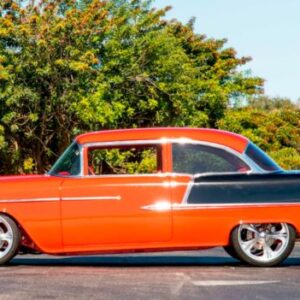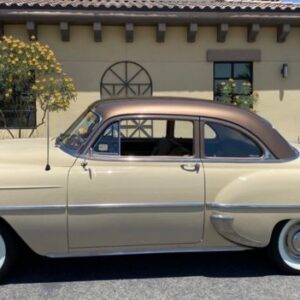The 1955 Porsche 550 Spyder is a legendary sports car that made a lasting impact on the automotive world. Renowned for its performance, design, and racing heritage, the 550 Spyder continues to captivate car enthusiasts and collectors alike.
-1686821008.jpg)
In this article, we will explore the key aspects of the 1955 Porsche 550 Spyder, including its history, design, performance, and legacy.
1. History
The Porsche 550 Spyder was introduced in 1953 as the company’s first purpose-built race car. The “550” designation was derived from the car’s 550-kilogram weight. The 1955 model year marked the second generation of the 550 Spyder, featuring various improvements and refinements over its predecessor. This iconic sports car established Porsche as a formidable competitor in international motorsports, with numerous victories in prestigious races like the Targa Florio and Carrera Panamericana.
2. Design
The 1955 Porsche 550 Spyder is a classic sports car known for its sleek and aerodynamic design. Here are some details about its design:
Exterior Design
The Porsche 550 Spyder featured a low-slung and curvaceous body, designed with a focus on aerodynamics to enhance performance. It had a minimalist design approach, with clean lines and smooth surfaces.
The car had a compact and lightweight construction, measuring approximately 3.9 meters (153 inches) in length. The front end had a rounded shape with integrated headlights and a small front grille for cooling.
The rear end featured a distinctive rounded tail section with prominent fenders and a single exhaust outlet. It had a removable lightweight hardtop, and some versions featured a small, removable windshield.
Interior Design
The 550 Spyder had a simple and functional interior, reflecting its racing heritage. The cockpit was designed for the driver, with a minimalistic dashboard and a three-spoke steering wheel.
-1686821149.jpg)
The instrument cluster consisted of a centrally placed tachometer and speedometer, providing essential information for the driver. The seats were thinly padded and lacked excessive cushioning to reduce weight and provide better feedback to the driver. Interior materials were basic and focused on functionality rather than luxury.
Chassis and Suspension
The Porsche 550 Spyder utilized a tubular space-frame chassis, constructed from lightweight steel or aluminum, which contributed to its low weight. The suspension system consisted of independent front suspension with trailing arms and torsion bars, offering precise handling and a balanced ride. At the rear, it featured swing axles with trailing arms and transverse torsion bars, designed to provide stability and control during cornering.
3. Engine and Performance
The 1955 Porsche 550 Spyder was equipped with a rear-mounted, air-cooled, flat-four engine. Here are the specifications of the engine:
Displacement
The engine had a displacement of 1.5 liters (1498 cc). It’s worth noting that in later versions, Porsche increased the engine size to 1.6 liters (1582 cc) and 1.7 liters (1680 cc) to extract more power.
-1686821187x1024.jpg)
Configuration
The engine had a horizontally opposed (“flat”) cylinder configuration, with two cylinders on each side facing each other. This design helped keep the engine compact and contributed to a low center of gravity.
Carburetion
The engine utilized dual carburetors, specifically two Solex 40 PJJ carburetors, to provide the necessary fuel-air mixture for combustion.
-1686821384x1024.jpg)
Horsepower
The engine produced around 110 horsepower at 6,200 rpm. This was quite impressive for a car of its time and contributed to its spirited performance.
Cooling
Being an air-cooled engine, the 550 Spyder’s power plant relied on cooling fins and airflow for heat dissipation. The absence of liquid cooling components helped reduce weight and complexity.
Transmission
The engine was paired with a manual transmission, typically a four-speed gearbox, which transmitted power to the rear wheels.
Performance
Thanks to its lightweight construction and powerful engine, the 550 Spyder delivered impressive performance. It could achieve a top speed of around 135 mph (217 km/h) and accelerate from 0 to 60 mph (0 to 97 km/h) in approximately 9 seconds.
-1686821224.jpg)
The Porsche 550 Spyder evolved over time, and different versions may have had variations in engine specifications. The information provided here pertains specifically to the 1955 model.
4. Sales and Production
The Porsche 550 Spyder was a limited-production race car, with only around 90 units built between 1953 and 1956. While complete sales figures for the 1955 model year specifically are not readily available, it is clear that the 550 Spyder was a niche product aimed at racing enthusiasts and discerning sports car aficionados.
Production of the 550 Spyder was focused on creating a lightweight, high-performance vehicle that could excel on the racetrack. As a result, the production process was highly specialized, with each car being meticulously crafted to ensure top-quality performance and handling. The limited production numbers contributed to the car’s exclusivity and desirability, both during its production run and in the years that followed.
The 550 Spyder was not intended to be a mass-market product, as Porsche’s focus at the time was on building race cars with the potential to succeed in competitive motorsports events. However, the 550 Spyder’s success on the track, combined with its striking design and impressive performance, helped to establish Porsche as a respected sports car manufacturer and laid the groundwork for the company’s future road cars, such as the iconic Porsche 911.
While production and sales numbers for the 1955 Porsche 550 Spyder were relatively limited due to the car’s specialized nature and niche market, its influence on the automotive world and Porsche’s subsequent successes cannot be understated. The 550 Spyder remains a highly sought-after classic car among collectors and enthusiasts, thanks to its rarity, performance capabilities, and timeless design.
5. Market Reception of the 1955 Porsche 550 Spyder
The 1955 Porsche 550 Spyder was received with great enthusiasm by both the racing community and the general public. Its combination of performance, design, and innovation struck a chord with sports car enthusiasts, and the 550 Spyder quickly gained a reputation as a desirable and competitive car both on and off the track.
Racing Community
The 550 Spyder’s racing successes played a significant role in shaping its market reception. Its victories in various prestigious races, such as the Targa Florio and Carrera Panamericana, demonstrated the car’s exceptional performance capabilities and reliability. The car’s dominance in the 1.5-liter class, along with its impressive performance in Sports Car Club of America (SCCA) events, attracted the attention of professional drivers and racing teams, who recognized the 550 Spyder as a formidable competitor.
-1686821280x1024.jpg)
These racing achievements helped to establish Porsche’s reputation as a serious contender in international motorsports and contributed to the growing interest in the 550 Spyder among racing enthusiasts.
General Public
The 1955 Porsche 550 Spyder also captured the imagination of the general public, who were drawn to its sleek design and exciting performance. The car’s low-slung profile, and aerodynamic shape gave it a unique and appealing aesthetic that was unlike anything else on the market at the time.
Its exceptional performance, combined with its striking design, made the 550 Spyder a highly desirable sports car among car enthusiasts. The car’s association with celebrities, such as actor James Dean, who famously owned and tragically died in a 550 Spyder, further contributed to the car’s allure and mystique.
6. Limited Production and Collectability
The Porsche 550 Spyder was produced in limited numbers, with only around 90 units built between 1953 and 1956. This exclusivity added to the car’s appeal and made it even more desirable among collectors and enthusiasts. The 550 Spyder’s rarity, along with its racing pedigree and iconic design, have made it a highly sought-after classic car in today’s market, commanding high prices at auctions and private sales.
The market reception of the 1955 Porsche 550 Spyder was overwhelmingly positive, thanks to its impressive performance, innovative design, and racing success. The car’s unique combination of form and function, along with its limited production and cultural significance, have ensured its enduring appeal and status as an iconic and highly collectible classic sports car.
7. Cultural Values
The 1955 Porsche 550 Spyder holds significant cultural value due to several factors:
Motorsport Heritage
The 550 Spyder’s racing success and its association with prestigious events like the Carrera Panamericana and Targa Florio have established it as an iconic racing car. It represents Porsche’s early achievements in motorsport and their dedication to performance and engineering excellence.
James Dean Connection
The tragic accident involving actor James Dean and his 550 Spyder in 1955 created a lasting cultural impact. It elevated the car’s status to legendary proportions and added an aura of mystique and fascination around the model. The association with Dean further contributed to the car’s iconic status and cultural significance.
-1686821331x1024.jpg)
Design and Aesthetics
The 550 Spyder’s sleek and aerodynamic design has become an enduring symbol of automotive beauty and elegance. Its minimalist and purposeful design approach influenced subsequent Porsche models and left a lasting impact on automotive design in general.
Rarity and Collectibility
The limited production numbers and the car’s status as a highly sought-after collector’s item have elevated its cultural value. The 550 Spyder’s rarity and historical significance make it a coveted possession for collectors and enthusiasts, representing a pinnacle of automotive engineering and design.
-1686821345.jpg)
Porsche Legacy
The 550 Spyder played a significant role in shaping Porsche’s legacy as a manufacturer of high-performance sports cars. It embodies the core values of the brand, such as engineering excellence, precision, and a passion for motorsport. The car’s cultural value extends beyond itself, representing the wider impact Porsche has had on automotive culture.





